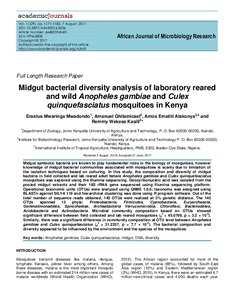| dc.contributor.author | Mwadondo, E.M. |
| dc.contributor.author | Ghilamicael, A. |
| dc.contributor.author | Alakonya, A.E. |
| dc.contributor.author | Kasili, R.W. |
| dc.date.accessioned | 2019-12-04T11:11:25Z |
| dc.date.available | 2019-12-04T11:11:25Z |
| dc.date.issued | 2017-08 |
| dc.identifier.citation | Mwadondo, E.M., Ghilamicael, A., Alakonya, A.E. & Kasili, R. W. (2017). Midgut bacterial diversity analysis of laboratory reared and wild Anopheles gambiae and Culex quinquefasciatus mosquitoes in Kenya. African Journal of Microbiology Research, 11(29), 1171-1183. |
| dc.identifier.issn | 1996-0808 |
| dc.identifier.uri | https://hdl.handle.net/20.500.12478/2427 |
| dc.description | Open Access Journal |
| dc.description.abstract | Midgut symbiotic bacteria are known to play fundamental roles in the biology of mosquitoes, however knowledge of midgut bacterial communities associated with mosquitoes is scanty due to limitation of the isolation techniques based on culturing. In this study, the composition and diversity of midgut bacteria in field collected and lab reared adult female Anopheles gambiae and Culex quinquefasciatus mosquitoes was explored using the Illumina sequencing. Deoxyribonucleic acid was isolated from the
pooled midgut extracts and their 16S rRNA gene sequenced using Illumina sequencing platform. Operational taxonomic units (OTUs) were analyzed using QIIME 1.8.0; taxonomy was assigned using BLASTn against SILVA 119 and hierarchical clustering was done using R program software. Out of the total number of sequence reads obtained, 145 OTUs were realized at 3% genetic distance. The 145 OTUs spanned 12 phyla; Proteobacteria, Firmicutes, Cyanobacteria, Euryarchaeota, Gemmatimonadetes, Spirochaetae, Archeabacteria Verrucomicrobia, Chloroflexi, Bacteriodetes, Acidobacteria and Actinobacteria. Microbial community composition based on OTUs showed significant difference between field collected and lab reared mosquitoes (ᵪ2 = 45.0799, p = 3.2 × 10-5). Similarly, there was a significant difference in community composition at OTU level between Anopheles
gambiae and Culex quinquefasciatus (ᵪ2 = 31.2257, p = 7.7 × 10-4). The bacterial composition and diversity appeared to be influenced by the environment and the species of the mosquitoes. |
| dc.format.extent | 1171-1183 |
| dc.language.iso | en |
| dc.subject | Anopheles Gambiae |
| dc.subject | Culex Quinquefasciatus |
| dc.subject | Dna |
| dc.subject | Mosquitoes |
| dc.subject | Midgut |
| dc.subject | Diversity |
| dc.title | Midgut bacterial diversity analysis of laboratory reared and wild Anopheles gambiae and Culex quinquefasciatus mosquitoes in Kenya |
| dc.type | Journal Article |
| dc.description.version | Peer Review |
| cg.contributor.crp | Roots, Tubers and Bananas |
| cg.contributor.affiliation | Jomo Kenyatta University of Agriculture and Technology |
| cg.contributor.affiliation | International Institute of Tropical Agriculture |
| cg.coverage.region | Africa |
| cg.coverage.region | West Africa |
| cg.coverage.country | Kenya |
| cg.authorship.types | CGIAR and developing country institute |
| cg.iitasubject | Disease Control |
| cg.journal | African Journal of Microbiology Research |
| cg.howpublished | Formally Published |
| cg.accessibilitystatus | Open Access |
| local.dspaceid | 92532 |
| cg.targetaudience | Scientists |
| cg.identifier.doi | http://dx.doi.org/10.5897/ajmr2016.8256 |

